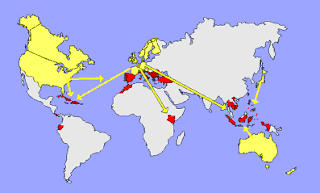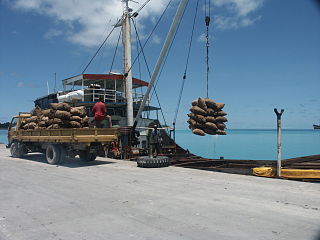
HIV/AIDS originated in the early 20th century and has become a major public health concern and cause of death in many countries. AIDS rates varies significantly between countries, with the majority of cases concentrated in Southern Africa. Although the continent is home to about 15.2 percent of the world's population, more than two-thirds of the total population infected worldwide – approximately 35 million people – were Africans, of whom around 1 million have already died. Eastern and Southern Africa alone accounted for an estimate of 60 percent of all people living with HIV and 100 percent of all AIDS deaths in 2011. The countries of Eastern and Southern Africa are most affected, leading to raised death rates and lowered life expectancy among adults between the ages of 20 and 49 by about twenty years. Furthermore, life expectancy in many parts of Africa is declining, largely as a result of the HIV/AIDS epidemic, with life-expectancy in some countries reaching as low as thirty-nine years.

Bareback sex is physical sexual activity, especially sexual penetration, without the use of a condom. The topic primarily concerns anal sex between men without the use of a condom, and may be distinguished from unprotected sex because bareback sex denotes the deliberate act of forgoing condom use.
HIV/AIDS has been a public health concern for Latin America due to a remaining prevalence of the disease. In 2018 an estimated 2.2 million people had HIV in Latin America and the Caribbean, making the HIV prevalence rate approximately 0.4% in Latin America.

Female sex tourism is sex tourism by women who travel intending to engage in sexual activities with one or more locals, including male sex workers and female sex workers. Female sex tourists may seek aspects of the sexual relationship not typically shared by male sex tourists, such as perceived romance and intimacy. The incidence of female sex tourism is much lower than male sex tourism, and the low number of female sex tourists makes it difficult to research this phenomenon, which has been described as "poorly understood".
The Caribbean is the second-most affected region in the world in terms of HIV prevalence rates. Based on 2009 data, about 1.0 percent of the adult population is living with the disease, which is higher than any other region except Sub-Saharan Africa. Several factors influence this epidemic, including poverty, gender, sex tourism, and stigma. HIV incidence in the Caribbean declined 49% between 2001 and 2012. Different countries have employed a variety of responses to the disease, with a range of challenges and successes.
Abstinence, be faithful, use a condom, also known as the ABC strategy, abstinence-plus sex education or abstinence-based sex education, is a sex education policy based on a combination of "risk avoidance" and harm reduction which modifies the approach of abstinence-only sex education by including education about the value of partner reduction, safe sex, and birth control methods. Abstinence-only sex education is strictly to promote the sexual abstinence until marriage, and does not teach about safe sex or contraceptives. The abstinence-based sex education program is meant to stress abstinence and include information on safe sex practices. In general terms, this strategy of sex education is a compromise between abstinence-only education and comprehensive sex education. The ABC approach was developed in response to the growing epidemic of HIV/AIDS in Africa, and to prevent the spread of other sexually transmitted infections. This approach has been credited by some with the falling numbers of those infected with AIDS in Uganda, Kenya and Zimbabwe, among others. From 1990 to 2001 the percentage of Ugandans living with AIDS fell from 15% to between 5 and 6%. This fall is believed to result from the employment of the ABC approach, especially reduction in the number of sex partners, called "Zero-Grazing" in Uganda.
Widow inheritance is a cultural and social practice whereby a widow is required to marry a male relative of her late husband, often his brother. The practice is more commonly referred as a levirate marriage, examples of which can be found in ancient and biblical times.
Prostitution in Kenya is widespread. The legal situation is complex. Although prostitution is not criminalised by National law, municipal by-laws may prohibit it.. It is illegal to profit from the prostitution of others, and to aid, abet, compel or incite prostitution.. UNAIDS estimate there to be 133,675 prostitutes in the country.

There are two major sources of fish in Uganda; one is from aquaculture, the other from fishing in rivers and lakes. The latter has made up the largest and most significant share of all fishing. Open water covers 15.3 percent of Uganda's surface and comprises five major lakes which are the main sources of fish in the country. Lake Victoria continues to be the most important water body in Uganda both in size and contribution to the total fish catch, followed by Lake Albert and Lake Kyoga.
Kenya has a severe, generalized HIV epidemic, but in recent years, the country has experienced a notable decline in HIV prevalence, attributed in part to significant behavioral change and increased access to ARV. Adult HIV prevalence is estimated to have fallen from 10 percent in the late 1990s to about 4.8 percent in 2017. Women face considerably higher risk of HIV infection than men but have longer life expectancies than men when on ART. The 7th edition of AIDS in Kenya reports an HIV prevalence rate of eight percent in adult women and four percent in adult men. Populations in Kenya that are especially at risk include injecting drug users and people in prostitution, whose prevalence rates are estimated at 53 percent and 27 percent, respectively. Men who have sex with men (MSM) are also at risk at a prevalence of 18.2%. Other groups also include discordant couples however successful ARV-treatment will prevent transmission. Other groups at risk are prison communities, uniformed forces, and truck drivers.
Infection rates of HIV/AIDS in Mali are estimated to be under 2%, which is relatively low compared to other parts of Africa, although the infection rate is higher among women of childbearing age. However, this figure is most likely deceptive; the problem in attempting to estimate infection rates is that voluntary testing is rare. Women who give birth in a hospital are automatically tested, but others in the general population rarely present themselves for testing. National education campaigns have targeted the general population since the late 1990s, as government and international organizations are concerned that Malians may be vulnerable to the spread of the pandemic. Since 2002, the Supreme National Council for AIDS (HCNLS) has coordinated educational campaigns around sexual activity and condom use to stem HIV infection. Condom use remains low by international standards.
HIV/AIDS in Eswatini was first reported in 1986 but has since reached epidemic proportions. As of 2016, Eswatini had the highest prevalence of HIV among adults aged 15 to 49 in the world (27.2%).

As of 2012, approximately 1,100,000 people in Malawi are HIV-positive, which represents 10.8% of the country's population. Because the Malawian government was initially slow to respond to the epidemic under the leadership of Hastings Banda (1966–1994), the prevalence of HIV/AIDS increased drastically between 1985, when the disease was first identified in Malawi, and 1993, when HIV prevalence rates were estimated to be as high as 30% among pregnant women. The Malawian food crisis in 2002 resulted, at least in part, from a loss of agricultural productivity due to the prevalence of HIV/AIDS. Various degrees of government involvement under the leadership of Bakili Muluzi (1994–2004) and Bingu wa Mutharika (2004–2012) resulted in a gradual decline in HIV prevalence, and, in 2003, many people living in Malawi gained access to antiretroviral therapy. Condoms have become more widely available to the public through non-governmental organizations, and more Malawians are taking advantage of HIV testing services.
Since HIV/AIDS was first reported in Thailand in 1984, 1,115,415 adults had been infected as of 2008, with 585,830 having died since 1984. 532,522 Thais were living with HIV/AIDS in 2008. In 2009 the adult prevalence of HIV was 1.3%. As of 2016, Thailand had the highest prevalence of HIV in Southeast Asia at 1.1 percent, the 40th highest prevalence of 109 nations.
With 1.28 percent of the adult population estimated by UNAIDS to be HIV-positive in 2006, Papua New Guinea has one of the most serious HIV/AIDS epidemics in the Asia-Pacific subregion. Although this new prevalence rate is significantly lower than the 2005 UNAIDS estimate of 1.8 percent, it is considered to reflect improvements in surveillance rather than a shrinking epidemic. Papua New Guinea accounts for 70 percent of the subregion's HIV cases and is the fourth country after Thailand, Cambodia, and Burma to be classified as having a generalized HIV epidemic.
Malawi ranks 170th out of 174 in the World Health Organization lifespan tables; 88% of the population live on less than £2.40 per day; and 50% are below the poverty line.
Prostitution in Malawi is legal and prevalent around hotels and bars in urban and tourist areas. Living off the proceeds of prostitution is illegal. In 2015, it was estimated there were 20,000 sex workers in the country.
Prostitution in Somalia is officially illegal. There is generally very little voluntary prostitution in the country according to the African Medical Research and Education Foundation (AMREF). UNAIDS estimated there were 10,957 sex workers in Somalia in 2016.

KoreKorea was a term used for girls in Kiribati who Korean fishermen paid for sex. They are now called ainen matawa locally "in deference to Korean sensitivities", because the word "Korekorea" was overtly linked to the "principal nationality of their clients". Some of the girls are as young as fourteen years old. They board foreign fishing vessels and engage in sex in exchange for money, clothes and fish.
A sexual rite of passage is a ceremonial event that marks the passage of a young person to sexual maturity and adulthood, or a widow from the married state to widowhood, and involves some form of sexual activity.





